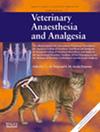Comparing intramuscular ketamine with peri-incisional bupivacaine with or without ketamine in dogs undergoing hemilaminectomy
IF 1.9
2区 农林科学
Q2 VETERINARY SCIENCES
引用次数: 0
Abstract
Objective
To investigate whether infiltrating bupivacaine with ketamine into the epaxial muscles improves quality and duration of analgesia perioperatively compared with bupivacaine alone or ketamine intramuscularly.
Study design
Prospective blinded randomized clinical study.
Animals
A group of 66 dogs randomized into three groups (n = 22).
Methods
Before surgery, bupivacaine 0.5% 2 mg kg–1 alone (group B) or combined with ketamine 2 mg kg–1 (group BK) was infiltrated peri-incisionally into the epaxial muscles. Group K received ketamine 2 mg kg–1 injected intramuscularly into a cervical muscle without infiltration. Meloxicam 0.2 mg kg–1 was given intravenously (IV) before moving to theatre. Cardiovascular variables: heart rate and systolic, mean and diastolic blood pressure were recorded. Intraoperative fentanyl 5 μg kg–1 IV was administered if these variables increased by 20% from baseline. Fentanyl continuous infusion (5 μg kg–1 hour–1) was started if more than three boluses were required. The Glasgow Composite Pain Scale-Short Form was used pre- and postoperatively for acute pain assessment at different time intervals; methadone 0.2 mg kg–1 IV was administered if scores were greater 5/20. Analgesia requirements, time to first administration, pain scores, total opioids interventions, need for sedation, first food intake and adverse effects were recorded. Continuous, normally distributed and non-normally distributed variables were analysed using ANOVA or Kruskal Wallis test, respectively.
Results
No significant difference was found for cardiovascular variables between groups over time, intra- or postoperative analgesia requirements, time to administration, pain scores total opioids, time to first food intake, sedation and occurrence of adverse effects.
Conclusions and clinical relevance
No difference in perioperative rescue analgesia was found between groups.
在半椎板切除犬中,肌内注射氯胺酮与布比卡因(含或不含氯胺酮)切口周围的比较。
目的:探讨布比卡因联合氯胺酮肌内浸润比单独布比卡因或氯胺酮肌内浸润是否能改善围手术期镇痛质量和持续时间。研究设计:前瞻性盲法随机临床研究。动物:66只狗随机分为三组(n = 22)。方法:术前单独布比卡因0.5% 2 mg kg-1 (B组)或联合氯胺酮2 mg kg-1 (BK组)经切口周围浸润至外轴肌。K组给予氯胺酮2 mg kg-1颈肌肌内注射,无浸润。入院前静脉滴注美洛昔康0.2 mg kg-1。心血管变量:记录心率、收缩压、平均血压和舒张压。如果这些变量比基线增加20%,则术中给予芬太尼5 μg kg-1 IV。芬太尼连续输注(5 μg kg-1小时-1)如需3大剂量则开始。术前和术后在不同时间间隔使用格拉斯哥复合疼痛量表-短表进行急性疼痛评估;评分大于5/20者给予美沙酮0.2 mg kg-1静脉注射。记录镇痛需求、首次给药时间、疼痛评分、总阿片类药物干预、镇静需求、首次食物摄入量和不良反应。连续、正态分布和非正态分布变量分别采用方差分析或Kruskal Wallis检验进行分析。结果:两组间心血管变量在时间、术中或术后镇痛需求、给药时间、疼痛评分、总阿片类药物、首次进食时间、镇静作用和不良反应发生等方面均无显著差异。结论及临床意义:两组患者围手术期抢救镇痛效果无显著差异。
本文章由计算机程序翻译,如有差异,请以英文原文为准。
求助全文
约1分钟内获得全文
求助全文
来源期刊

Veterinary anaesthesia and analgesia
农林科学-兽医学
CiteScore
3.10
自引率
17.60%
发文量
91
审稿时长
97 days
期刊介绍:
Veterinary Anaesthesia and Analgesia is the official journal of the Association of Veterinary Anaesthetists, the American College of Veterinary Anesthesia and Analgesia and the European College of Veterinary Anaesthesia and Analgesia. Its purpose is the publication of original, peer reviewed articles covering all branches of anaesthesia and the relief of pain in animals. Articles concerned with the following subjects related to anaesthesia and analgesia are also welcome:
the basic sciences;
pathophysiology of disease as it relates to anaesthetic management
equipment
intensive care
chemical restraint of animals including laboratory animals, wildlife and exotic animals
welfare issues associated with pain and distress
education in veterinary anaesthesia and analgesia.
Review articles, special articles, and historical notes will also be published, along with editorials, case reports in the form of letters to the editor, and book reviews. There is also an active correspondence section.
 求助内容:
求助内容: 应助结果提醒方式:
应助结果提醒方式:


